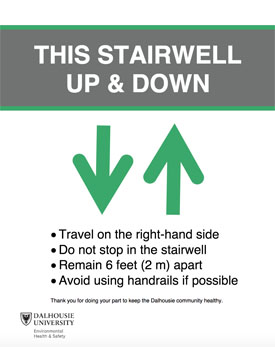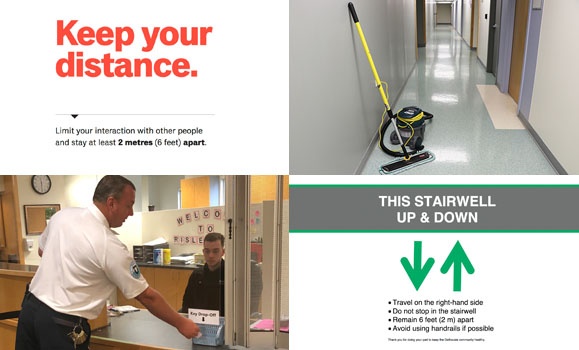Dalhousie's campuses will look and feel a little different for staff, faculty, and students returning to campus in limited numbers starting this summer and into fall.
This month — joining the front-line workers who have remained throughout the COVID-19 pandemic — researchers, campus support staff and others are being approved to return to campus in cases where they have been unable to conduct their work remotely and provided their work can be done following approved safety protocols.
While most employees will continue to work remotely from home, and the majority of classes will be delivered online this fall, the number of individuals working on campus is expected to increase gradually in a phased approach over the coming months.
Those who are returning to campus must abide by protocols created by Dal’s Environmental Health and Safety (EHS) office and reviewed by Nova Scotia’s departments of Public Health and Labour and Advanced Education. Some of the new measures enacted by the university have resulted in physical changes to campus spaces and how they function, while others bring shifts in expectations around behaviour.
“All of us must do our part to ensure the continued health and well-being of everyone who works at, studies on, or is a visitor to our campuses,” wrote Frank Harvey, acting provost and vice-president academic, and Ian Nason, vice-president finance, in a recent email to faculty and staff.
Below, we’ve captured some of EHS’s main guidelines and links to other resources where you can find more information.
 Maintaining distance
Maintaining distance
One of the best means of protection against COVID-19 is physical distancing. Each active workspace is expected to have a physical distancing plan to address unique needs and circumstances. A minimum distance of two metres (or six feet) between people should be maintained at all times, and in-person group meetings are to be avoided where possible. When in-person meetings cannot be avoided, physical distancing protocols must be met.
The university has designed directional arrows and one-way signage for use in locations such as hallways, stairwells and corridors where distancing can be challenging. Occupancy limits have also been set for some locations such as meeting rooms, washrooms, break rooms or elevators. Physical distancing markers and other visual aids (available for purchase via Facilities Management) may be used to help ensure proper distances are maintained. In some cases, furniture will be reconfigured in workspaces and large common areas to facilitate distancing.
 Physical barriers
Physical barriers
Physical barriers may be used in cases where employees are required and where physical distancing cannot be easily maintained. Barriers must be sufficient in size to provide protection to workers and be installed securely so as to pose no hazard to employees. Employees must be able to complete their tasks unhindered when a barrier is in place and plans must be developed for the cleaning and maintenance of barriers.
 Enhanced cleaning and disinfecting
Enhanced cleaning and disinfecting
Frequent cleaning and disinfecting of high-touch surfaces and objects can help prevent the spread of COVID-19, which is why the university’s Custodial Services team will provide enhanced cleaning presence during the pandemic. This includes a minimum twice-per-day cleaning of frequently touched surfaces in common building areas, including doorknobs, light switches, handrails, bathrooms and more. Office leaders are expected to manage increased local-level cleaning on shared equipment such as photocopiers, phones, desks, physical barriers, keyboards, desks and other similar surfaces. Items that cannot be easily cleaned (such as magazines, books, and newspapers, for example) are to be removed.
 Administrative adjustments
Administrative adjustments
Leaders at Dalhousie will be expected to assess their local operations and implement any additional administrative controls to address specific hazards related to their workspaces and the specific tasks performed. These might include shift rotations, safe work procedures that describe how different tasks or situation should be handled (interacting with visitors, local cleaning, shipping/receiving packages), and installing signs and information posters with reminders about symptoms, handwashing and physical distancing.
 Masks, gloves and glasses
Masks, gloves and glasses
Aligned with the Province of Nova Scotia’s directive, Dalhousie University is requiring the use of non-medical masks or face coverings in most indoor common spaces on our campuses as a public health measure to help keep our community safe and limit the potential spread of COVID-19.
This directive, which came into effect July 31, is being implemented in alignment with our peer universities across Nova Scotia along with recommendations set out by Nova Scotia Public Health. Read more about non-medical mask protocols at Dal, where there are exceptions, and what grade of mask is required when physical distancing can’t be maintained.
Appropriate PPE for non-COVID-19 related hazards (i.e. chemical hazards, particulate hazards, biological/radiological hazards, etc.) are still required to complete these tasks. Leaders are expected to assess the need for PPE after determining the effectiveness of other existing controls.
Disposable gloves and eye protection are recommended when workers may be in direct contact with an ill person, or a contaminated object or environment. Frequent and thorough hand washing, as well as not touching one’s face, are still required while using gloves or eye protection.
 Infection monitoring and daily self-symptom checks
Infection monitoring and daily self-symptom checks
Employees are expected to self-check for the signs and symptoms of COVID-19 daily. If an employee notices they have any of the signs or symptoms of COVID-19, they are to follow guidance from Public Health, refrain from traveling to campus and notify their manager or supervisor. If they begin showing symptoms while on campus, they should self-isolate, follow Public Health guidance, and notify their manager or supervisor. If exposed to COVID-19 suspected cases within their household, employees should remain home and follow Public Health advice on when they may return.
Additional resources and information
For all employees
- Safety Training Video
- Additional safety courses
- Guide to using disinfectants (Faculty/staff login required)
For Managers, Supervisor, Leaders and Administrators
- Return to campus safety guidelines
- Signage catalogue (Faculty/staff login required)
- Safe work practices (Faculty/staff login required)
- Facilities Management (FAMIS requests)
For Labs
- Startup checklist (Faculty/staff login required)
- Laboratory Orientation Checklist (Faculty/staff login required)
Comments
comments powered by Disqus

